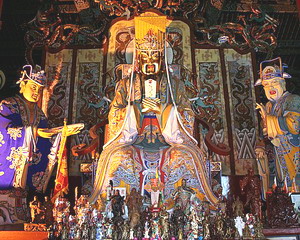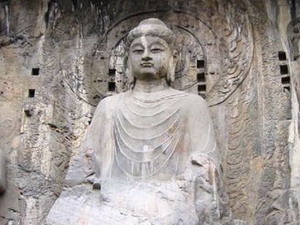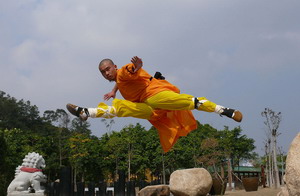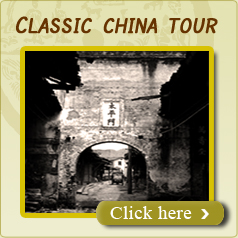Guanlin Temple

Guanlin Temple, about seven kilometers (about 4.5 miles) south of Luoyang City, was built in 1596, during the reign of Emperor Wanli in the Ming Dynasty (1368-1644) and was expanded in the Qing Dynasty (1644-1911). It is called General Guan's Tomb as well. The temple here makes a convenient stop on the way to or from the Longmen caves. From Luoyang, don't get off at the main stop in the centre of town, but go to the next stop along, at the end of the red crenellated wall on the east side of the road. The temple is at the end of Guanlin Nan Lu, which leads east off from the main road, by this bus stop.
Guanlin Temple is the place where Guan Yu's head was buried. After he was murdered by people of the Wu Kingdom, his head was sent to Cao Cao in order to frame Cao Cao and start a fight between the Shu Kingdom and the Wei Kingdom. However, Cao Cao discovered their plot. Due to his great respect for General Guan Yu, Cao Cao had Guan Yu's body carved from eaglewood and buried the carving and the head with great honors outside the South Gate of Luoyang City.
Guan Yu became a legendary hero in Chinese folktales because of his bravery and faithfulness. He was also respected as "Wu Sheng" by Chinese emperors. Temples were built for him throughout the country and he was honored as a god. Portraits or pictures of Guan Yu can be found on the doors of Chinese houses during the Lunar New Year because people believe he protects the home. Emperors of succeeding dynasties all revered Guan Yu a lot and even worshiped him as God of War. As a result, the temple in Luoyang is splendid and grandiose.
The temple covers an area of 100 mu (about 16.5 acres). Inside the temple are halls, tablets, small stone lions and cypress. Despite its military theme, this temple is strikingly beautiful; the elegant Ming buildings are highly carved and richly decorated. Especially fine are the carved stone lionesses lining the path to the Main Hall. Each has a different expression and a different cub, some riding on their mother's back, some hiding coyly behind her paws.
In the first hall, look carefully at the eaves for rather comical images of Guan Yu fighting - he's the one on the red horse - and leading an army engaged in sacking a city engulfed by carved wooden flames. Inside stands a seven-metre-high statue of the general, resplendent in technicolour ceremonial robes with a curtain of beads hanging from his hat. More images of the general are in the second and third halls, whose decoration includes frescoes of warriors jousting and men playing "go". In side halls are exhibitions of art and some fine carved tombstones and massive stone animals - the sheep are excellent, the lions almost unrecognizable.
The layout of the temple highly embodies the traditional style of Chinese architecture. It is designed and built symmetrically. Moving north from the Opera tower, there is the Main Gate, the Courtesy Gate, the First Hall, the Second Hall, the Third Gate, and the Tomb of Guan Yu. The First Hall is most magnificent. On its main gate are a series of reliefs telling the well-known stories of Guang Yu. The views from other halls and places inside the temple are also beautiful.
An art gallery was also built inside the temple, displaying a collection of nearly 2000 ancient steles, epitaphs and stone inscriptions. More than seventy stone-tablets with calligraphic inscriptions are also found here. A five-meter-high stone stele with inscriptions written by emperors from different dynasties is found in the octagonal pavilion. They are really helpful to the research of ancient Chinese history.
It's a quiet place, well restored and brilliantly coloured against the grey and green background of stone and the many twisted cypresses. The mausoleums of emperors were called Ling, the tombs of marquis or kings were named Zhong and those of holy men such as Confucius or Guan Yu were called Lin, hence the name Guanlin.





